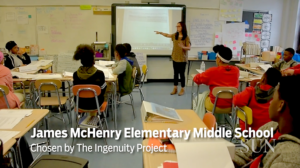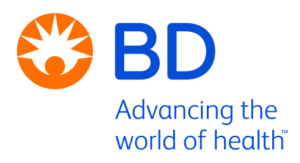
Lisette Morris froze when she saw a map showing where special academic programs for city schoolchildren were located. Wide swaths of West Baltimore were barren.“That really lit a fire for us,” she said.
Morris runs The Ingenuity Project, an advanced math and science program that’s operated in Baltimore since 1992. Its schools, which include Baltimore Polytechnic Institute and Roland Park Elementary/Middle, have been mostly concentrated in North Baltimore, in more affluent parts of the city.
The nonprofit hopes to change that, with plans to expand to James McHenry Elementary/Middle in the Hollins Market neighborhood next school year.
Just a few years ago, James McHenry was viewed as one of the worst schools in the state. Few students passed standardized tests, and families were fleeing to other schools. Then in 2017, the school was approved by the state as a “turnaround” program. Nearly all its teachers were fired, a new principal and other educators were brought in and the school has embraced a new mission: Build a place of excellence.
Now, some of the students who once languished in James McHenry classrooms will have access to accelerated STEM curriculum through Ingenuity, which aims to launch the next generation of competitive science, technology, engineering and math leaders. They’ll be set on a path that’s taken students at other Baltimore Ingenuity schools to Harvard, Yale and the Massachusetts Institute of Technology.
“We have talent across the city,” Morris said. “Students just need the opportunity to be with this rigorous curriculum and then the sky’s the limit.”
Ingenuity operates in three middle schools: Roland Park, Hamilton and Mount Royal. Baltimore Polytechnic Institute is its only high school. Morris said James McHenry was the first new addition in a decade, and beat out more than a dozen other schools that applied. It will help the program grow to serve more than 800 students by the 2020-2021 school year, up from around 600 now.
As James McHenry prepares to welcome The Ingenuity Project, the nonprofit is in the midst of implementing its 2020 strategic plan. At its heart is the need to bring in more diverse students and better reflect the city’s population. Last school year, roughly 44 percent of Ingenuity students were African-American and about 5 percent were Hispanic. Across the district, nearly 80 percent of students are black and 11 percent are Hispanic or Latino.
McHenry Principal Christophe Turk said his school’s selection as the next Ingenuity site is bigger than the thousands of dollars’ worth of new textbooks, teachers, scientific equipment and other resources the program will bring to 31 S. Schroeder St. It sends a message that the city believes in kids from the Hollins Market neighborhood, which has far more violent crime and far fewer jobs than in the city as a whole.
“This is about saying West Baltimore matters,” Turk said. “And the students and families here should be able to access flagship programming.”
Like the other Ingenuity schools, James McHenry will draw sixth-grade students from around the city to fill its inaugural 50 seats. The school is hosting a number of open houses to help spread the word. The Ingenuity Project is targeting students from about 15 elementary schools, almost all of them Title I programs — nearly all of them serving low-income populations — in nearby zip codes.
Though the program won’t roll out until the next school year, there’s already a sense of excitement around it at James McHenry. When Turk got the news that his school had been chosen, he gathered the students in the cafeteria. “We did that,” they chanted in unison.
Students, even those who will graduate from James McHenry before Ingenuity launches, say the program means people will be forced to quit underestimating kids from their neighborhood. Many are excited for their younger siblings or cousins to enroll. They see Ingenuity as the first step on a promising path: It will help more James McHenry kids get into selective high schools, which will help them get into esteemed colleges, which will set them up for a successful life. They’ll also gain entry to a strong alumni network.
In fact, an Ingenuity senior at Poly was recently named a semifinalist in the nation’s most prestigious high school science competition. The Regeneron Science Talent Search received more than 1,900 entries, and Michelle Mokaya placed among the top 300.
James McHenry has been around for decades, said eighth-grader Nazaiah Johnson, but too often its graduates are sucked into the troubles of life in Baltimore. Access to special learning opportunities, he said, could help “break the chain” of violence that students know too well.
“With this Ingenuity program, I hope we bring others here and boost up our reputation,” said Nazaiah, 13, who hopes to study physics at Oxford. “We’re letting everyone know our name.”
Amiya Thompson, 13, said that just because she attends school in a certain area of the city doesn’t mean she has to abide by expectations set by outsiders.
“You can go above,” she said, and participating in Ingenuity is a way to do that.
Morris said they’re working hard to expand access for children of color, who are underrepresented nationally in advanced learning programs. They’ve streamlined the application, hired a full-time recruiter and translated Ingenuity materials into Spanish.
“We should represent the city,” she said.
James McHenry Elementary Middle School becomes the first city school in west Baltimore to be chosen by The Ingenuity Project.
Video:
















